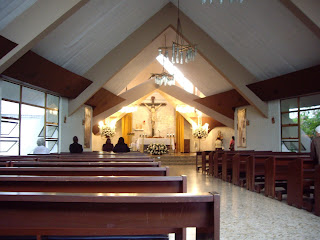Today marked the 30th anniversary of the assassination of Archbishop Oscar Romero. While I was in El Salvador, I was considering going back for the commemoration. But the more I thought about it, the more I realized that it would probably be a big disappointment. Even worse, it would probably have left me frustrated and angry. The lessons I am learning from my travels are all about remaining "at peace" in an increasingly troubled world. I would have been disturbed by the commemorations that have turned the remembrance of this great man's assassination into a "reality" show.
Other than a couple of articles online, including a comprehensive piece in
ConsortiumNews.org, I have seen no mention of the School of the Americas in Fort Benning, Georgia (renamed the Institute for Hemispheric Security Cooperation -- although its murderous mission is unchanged). Also called The School of the Assassins, in Latin America, it is called
La Escuela de Golpes (the Coup School). It is there that
Major Roberto D’Aubuisson, responsible for ordering the execution of Archbishop Romero, was trained.
There have been commemorative gatherings in churches of many denominations all over the world, but the main event in San Salvador is a very Roman Catholic one. The message of the Catholic Church hierarchy to the poor, who were so loved by Romero, is, as always, one of individualistic holiness and self-sacrifice in the hope of a heavenly reward. For themselves, and the powers that they support, the Church's message is one of continuing
impunity.
At the time of Romero’s assassination, El Salvador was ruled by a US-backed authoritarian regime that secured the interests of rich landowners. The Catholic Church hierarchy gave its support (as it has throughout the history of El Salvador and, indeed, all of Latin America) to the government of wealthy landowners and the military, and "
worked hand-in-glove with the CIA in anti-communist counterinsurgencies." However, there were certain Catholic priests who understood the message of the Gospels differently. Father
Rutilio Grande, a Jesuit and close friend of Romero's, was one of those who embraced "
Liberation Theology," combining the teachings of Christ with elements of Marxist theory, and seeing the mission of the Church in the world as one of uplifting the oppressed and supporting them in their efforts to achieve justice and dignity, even through armed struggle. On March 12, 1977, Rutilio Grande was assassinated.
This event was the turning point for Romero, who had recently been selected for the position of Archbishop because of his conservatism and because it was expected that he would maintain the
status quo in an increasingly turbulent time. However, with the assassination of Father Grande, he was transformed virtually overnight into a passionate defender of the rights of the poor, challenging the government, the military and even the Catholic Church hierarchy that gave its blessing to the oppressive regime. With this change, his fate was sealed. Three years later, on March 24, 1980, he was assassinated while saying Mass in the Chapel of the Hospital La Divina Providencia, where he lived.

His assassination fueled the war between leftist guerrillas and the US-backed government. As thousands of mourners gathered for his funeral, snipers from the National Army
opened fire on them, killing at least 50 people. By the time the war officially ended with the signing of peace accords in 1992, at least 79,000 people had been killed. At the end of the war, the FMLN (Frente Faribundo Martí para la Liberación Nacional) political party was formed by a coalition of guerrilla groups that had opposed the government. Even so, the fascist Nationalist Republican Alliance (ARENA) party continued to rule for 20 years, "elected" through massive fraud, and the United States continued to exercise its power over the Salvadoran people through the government's neoliberal policies. One thing is for sure: "...U.S. policy has been motivated by its refusal to tolerate any major redistribution of economic resources in Latin America" (in "
The Latin American Revolution II," by Asad Ismi, Canadian Centre for Policy Alternatives). With social unrest growing due to the increasing poverty resulting from the ARENA government's policies, the FMLN finally produced its first president, Mauricio Funes, in 2009. Funes, a “moderate” former television interview program host and former
correspondent for CNN en Español, has inherited the responsibility for leading a country wracked by extreme poverty, corruption and gang violence -- a situation that can (and I believe will) easily be exploited by the US through economic means and the CIA's usual covert destabilization activities.
Although the victory of the FMLN government was greeted by jubilation among the majority of Salvadorans, the hegemonic machinations of US geopolitics do not bode well for the new government, which has already begun bending over for the US. This posture is clearly shown by Omar Montilla, in a prescient article in Machetera, "
What is going on with Mauricio Funes?" This article is a "must read" for anyone interested in being able to predict El Salvador's future.
It is not the future for which Archbishop Romero gave his life.
Peace
